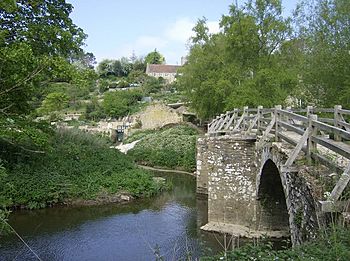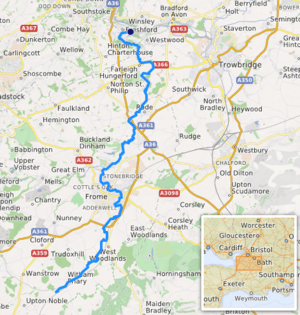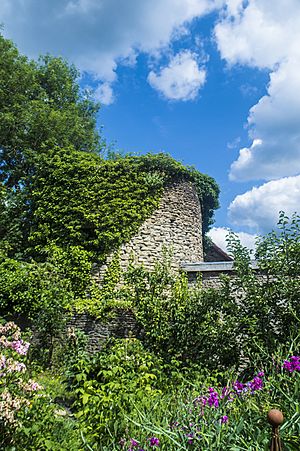River Frome, Somerset facts for kids
Quick facts for kids River Frome |
|
|---|---|

Bridge at Tellisford over the River Frome
|
|

Path of the River Frome [1]
|
|
| Country | England |
| County | Somerset |
| City | Frome |
| Physical characteristics | |
| Main source | Witham Friary, Mendip, Somerset, England 51°10′05″N 2°22′01″W / 51.16806°N 2.36694°W |
| River mouth | River Avon Freshford, Bath and North East Somerset, Somerset, England 51°20′17″N 2°17′50″W / 51.33806°N 2.29722°W |
| Length | 43 kilometres (27 mi) |
| Basin features | |
| Tributaries |
|
The River Frome is a river located in Somerset, England. It begins its journey near Witham Friary. The river then flows north through places like Blatchbridge and the town of Frome.
It continues generally north, passing between the Mendip Hills and Trowbridge. The River Frome finally joins the River Avon at Freshford, near Bradford on Avon.
The river is about 43 kilometers (27 miles) long. Its path includes different sections. For example, it flows for 15 km from its start to where the Maiden Bradley Brook joins it. It then travels 10 km through Frome to meet the Mells River. The last 18 km take it to the River Avon. After Frome, the river flows near villages like Beckington, Rode, Tellisford, Farleigh Hungerford, and Iford Manor.
The name "Frome" comes from an old British word, ffraw. This word means "fair," "fine," or "brisk." It describes how the river flows. The name was first written down in the year 701. At that time, Pope Sergius allowed Bishop Aldhelm to build a monastery "close to the river which is called From."
River Frome: Weirs and Bridges
The River Frome has many weirs. Weirs are small dams built across a river to control its flow. Some parts of the river, especially below Farleigh Hungerford, are popular for coarse fishing and trout fishing.
Many bridges cross the river. In the center of Frome, a bridge likely appeared in the 1300s. A later bridge from the 1500s was made wider in the 1700s. Buildings were even built on top of it.
This bridge is special because it is one of only three bridges in England with buildings on them. The other two are the Pulteney Bridge in Bath and the High Bridge in Lincoln.
Other important bridges include Wallbridge in Frome, built in 1634. Downstream, you can find Rode bridge, a turnpike bridge from around 1777. Tellisford bridge is a packhorse bridge, probably from the 1600s. Iford bridge dates back to about 1400, and Freshford bridge is from the 1500s.
River Frome: Mills and Industry
For hundreds of years, the River Frome provided power for many mills. At first, these mills ground flour for food. Later, as local industries grew, the mills changed.
They were used for fulling (making wool thicker), grinding dyewood (for dyes), and making grist (grain for animal feed or brewing). In the 1700s and early 1800s, there were over 30 mills along the Frome and its smaller rivers.
Some of these old mill buildings can still be seen today. You can find them at Tellisford, Rode, and Blatchbridge. The upstream mill at Wallbridge in Frome also remains. Other mills have disappeared over time.
In Frome, a large group of factory buildings for the wool industry once stood at Spring Gardens. These factories, owned by the Sheppard family, are now gone. The Town Mill was just upstream from Frome bridge. Today, only a few connected buildings remain. These include a partly ruined drying house and buildings for storage and dyehouses. Most of these have been turned into homes. The last textile mill, called Tuckers, closed in 1956.


